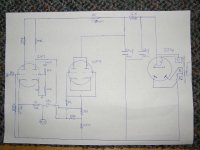Hi All,
I purchased a Soundtrak 130 Preamp a few months ago to have a play with, it was cheap and I didn't expect much from it but thought it would be interesting to tinker with.
From the website picture I could see 5 tubes, 1 being the 5z4 rectifier and what I thought would be a mix of 12AT/AU/AX 7's.
However upon receiving the pre I discovered it has 4 x 12AT7's.
On the rear of the unit there are 2 input RCA sockets and 4 output ones.
I plugged an amp into one set of outputs to hear a lot of audible hiss, so I tried the second set which was much better.
I opened the chassis to find that the quieter outputs had attenuation resistors soldered to the back of them which I thought was a fairly odd approach, I was thinking "why use 2 12at7's in the first place for a line level pre"?.
For anyone unfamiliar with the unit there is a volume control directly after the inputs with coupling caps feeding to the main board, paralleled across the inputs is a "timbre" control which is essentially a couple of caps and resistors designed as a basic tone control.
I spent a couple ofhours tracing the circuit from the board, leaving out the tone and volume controls, I'm pretty sure it's correct....
Coincidently, the board looks like it was designed as a small integrated amp as it has B9G socket landings for the front tubes and octal for the rear, but the rreas tubes have been wired with fly leads to take a B9G socket.
I'm fairly new to tubes and used to the usual layouts, can anyone explain to me what they were doing?
PS I have other pics of the actual construction if anyone's interested, Lots of glue used 🙁
I purchased a Soundtrak 130 Preamp a few months ago to have a play with, it was cheap and I didn't expect much from it but thought it would be interesting to tinker with.
From the website picture I could see 5 tubes, 1 being the 5z4 rectifier and what I thought would be a mix of 12AT/AU/AX 7's.
However upon receiving the pre I discovered it has 4 x 12AT7's.
On the rear of the unit there are 2 input RCA sockets and 4 output ones.
I plugged an amp into one set of outputs to hear a lot of audible hiss, so I tried the second set which was much better.
I opened the chassis to find that the quieter outputs had attenuation resistors soldered to the back of them which I thought was a fairly odd approach, I was thinking "why use 2 12at7's in the first place for a line level pre"?.
For anyone unfamiliar with the unit there is a volume control directly after the inputs with coupling caps feeding to the main board, paralleled across the inputs is a "timbre" control which is essentially a couple of caps and resistors designed as a basic tone control.
I spent a couple ofhours tracing the circuit from the board, leaving out the tone and volume controls, I'm pretty sure it's correct....
Coincidently, the board looks like it was designed as a small integrated amp as it has B9G socket landings for the front tubes and octal for the rear, but the rreas tubes have been wired with fly leads to take a B9G socket.
I'm fairly new to tubes and used to the usual layouts, can anyone explain to me what they were doing?
PS I have other pics of the actual construction if anyone's interested, Lots of glue used 🙁
Attachments
Last edited:
OK, you have cascaded common cathode stages feeding a cathode follower made from paralleled sections. Plenty of drive there.
The design uses both local and loop NFB. The common cathode stages don't have bypass caps. on the cathode resisters. That's local current NFB, AKA degeneration. The O/P coupling cap. feeds both the RCA jack and the NFB loop.
Even with losses due to degeneration, lots of open loop gain is present. That makes sense, as tone controls are present (not shown). TCs frequently "eat" gain.
The design uses both local and loop NFB. The common cathode stages don't have bypass caps. on the cathode resisters. That's local current NFB, AKA degeneration. The O/P coupling cap. feeds both the RCA jack and the NFB loop.
Even with losses due to degeneration, lots of open loop gain is present. That makes sense, as tone controls are present (not shown). TCs frequently "eat" gain.
- Status
- Not open for further replies.
